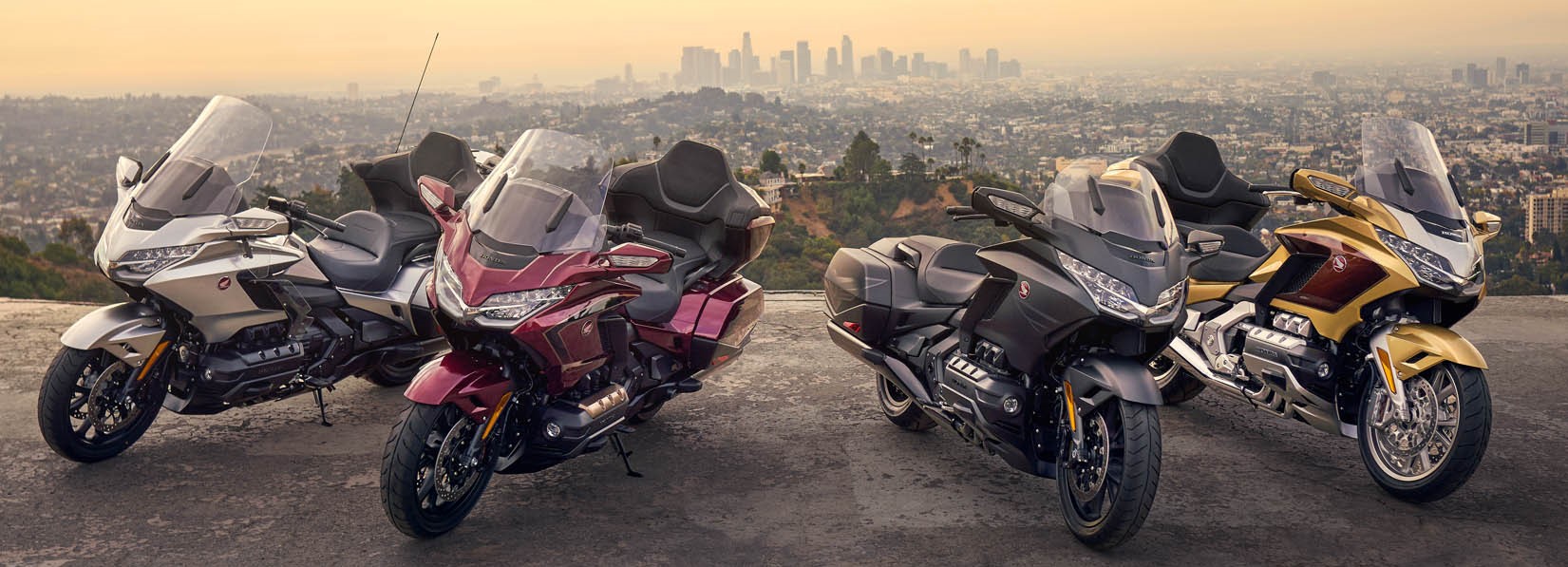
2025 Honda Gold Wing & Gold Wing Tour
- NO DEALER FEES = YOU SAVE MONEY! -
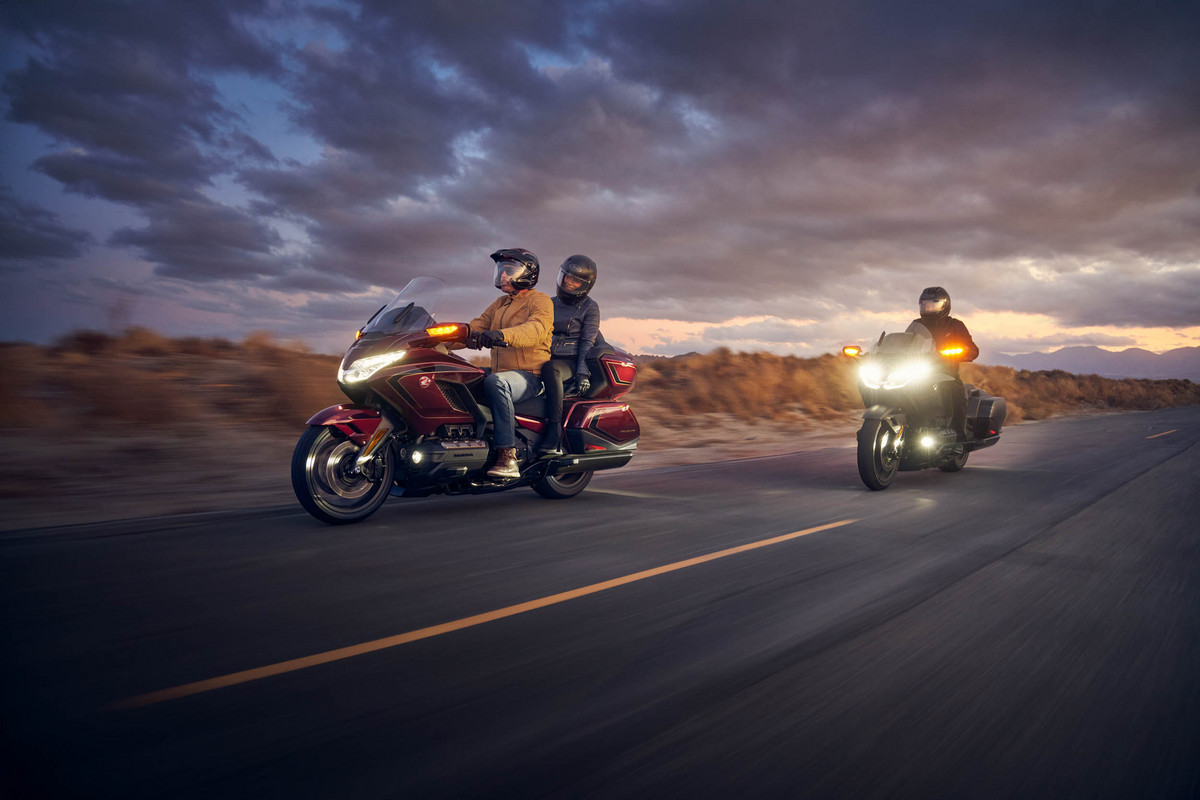
Honda confirmed today that its renowned Gold Wing—the model that kickstarted the touring movement following its 1975 debut—returns for 2025 with several styling touches to honor its 50th anniversary. The Gold Wing platform has evolved considerably in the half-century since its introduction, but it has always remained true to the vision of making long-distance motorcycle riding comfortable and enjoyable. For the 2025 model year, that mission is furthered through the addition of wireless compatibility for Apple CarPlay™ and Android Auto™, but most of the updates are centered on aesthetics, with distinctive colors and badges intended to mark the special occasion.

For model-year 2025, most Gold Wing versions also come with two free commemorative gifts: a coffee-table book covering the model's rich history, and a tabletop 3D 1:12 scale tabletop model, with a 1975 bike on one side and a 2025 motorcycle on the other.

Honda also has plans to mark the Gold Wing's fifth decade with a special display and activities during the upcoming Daytona Bike Week. More details will be released in the coming days.

"Honda has introduced many important powersports models over the years, but the Gold Wing is and always will be special, because of how it kickstarted the touring movement and inspired its own dedicated subculture," said Colin Miller, Manager of Public Relations at American Honda. "The Gold Wing has long demonstrated Honda's engineering prowess, but it's important to note that its development has often been customer-led. For these reasons and many others, the 50th anniversary of the Gold Wing platform is a significant milestone in Honda's history, and we're happy to mark the occasion with stunning touches to the 2025 model."
2025 Gold Wing
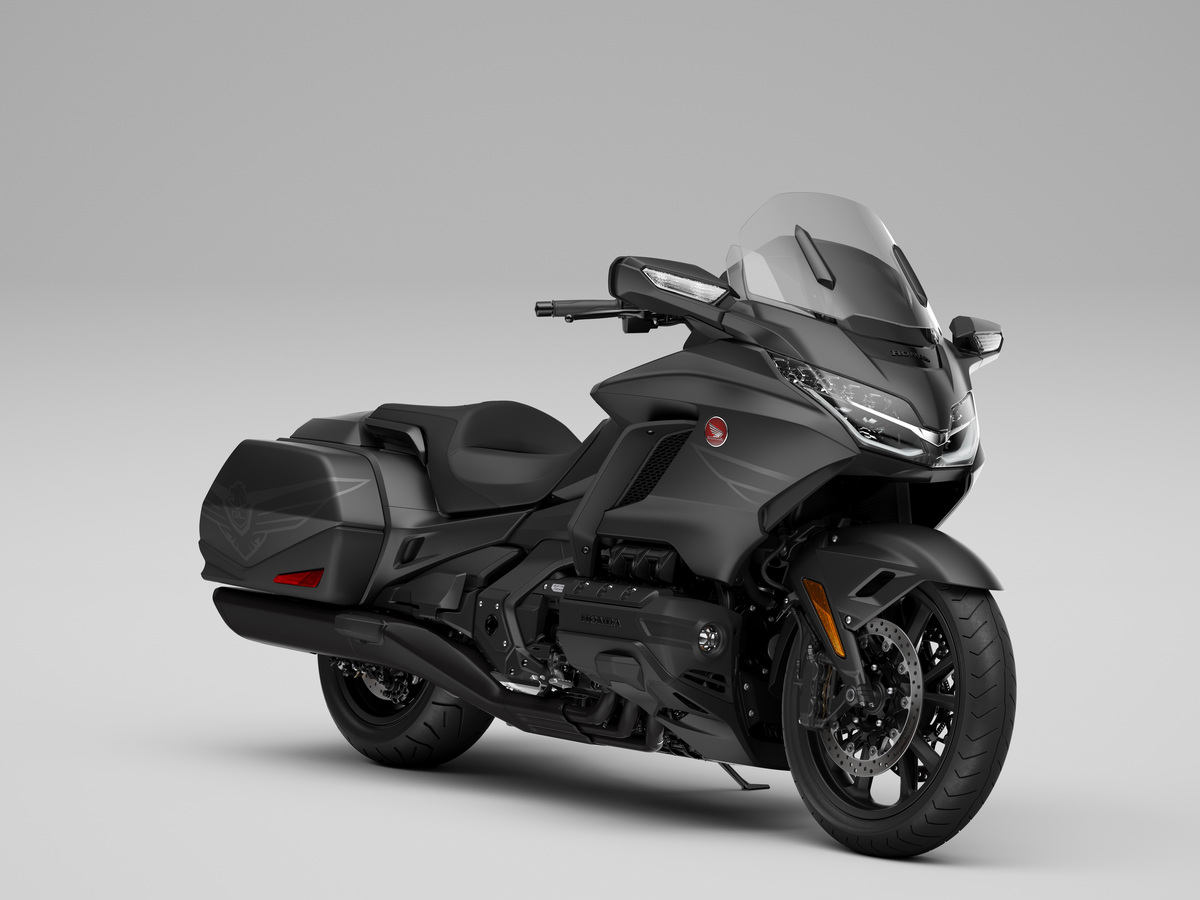
It wouldn't be a proper birthday party without the attendance of the Gold Wing's "bagger"-style versions, which follow the tradition of past trunkless models like the Valkyrie and F6B. Available with either a manual gearbox or Honda's advanced dual-clutch transmission, the standard Gold Wing is offered for 2025 in a Matte Black Metallic color, and to commemorate the platform's half-century milestone, it comes with several styling treatments, including bold Gold Wing logos across the saddlebags and side fairings. In addition, there's a special 50th Anniversary badge situated in front of the seat, and the meter's "opening ceremony" now displays "Since 1975" when the bike is turned on. As before, the standard Gold Wing has a shorter windscreen than the Tour versions, and for 2025, Apple CarPlay and Android Auto can now be accessed wirelessly.
- Color: Matte Black Metallic
- MSRP
- 50th Anniversary Gold Wing: $25,200
- 50th Anniversary Gold Wing DCT: $26,200
- 2025 Gold Wing Release Date: March
2025 Gold Wing Tour
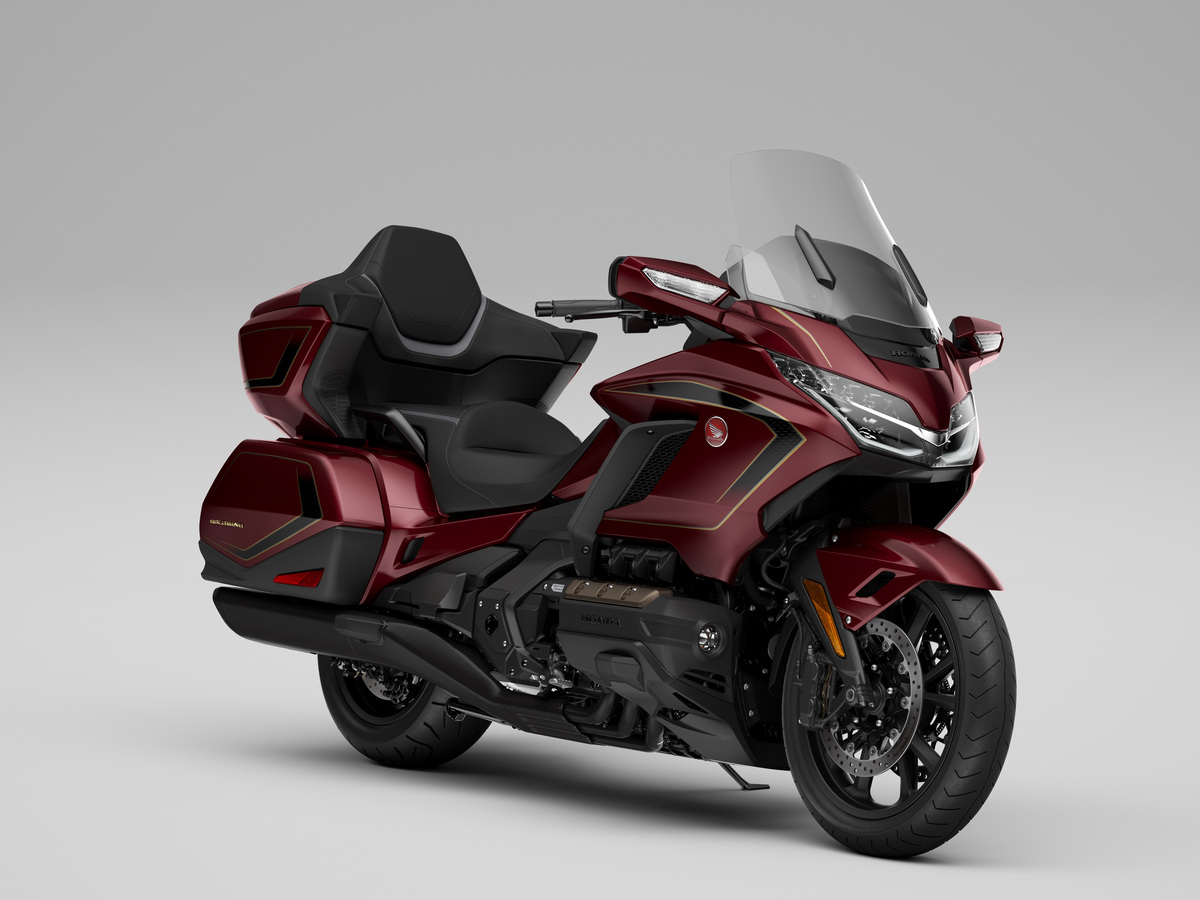
Honda's flagship touring machine celebrates its Golden Anniversary with three new colors for 2025. The Bourdeaux Red Metallic and Eternal Gold options both have subtle Gold Wing logos incorporated into the saddlebags, as well as the 50th Anniversary badge in front of the seat. (The Light Silver Metallic option is not considered a 50th Anniversary edition, and it is not badged as such.) The Gold Wing is the first and still the only motorcycle offered in an airbag version, featuring technology that operates via an acceleration sensor and main control unit (the Airbag version is available only in Bourdeaux Red Metallic).
- Colors
- 50th Anniversary Gold Wing Tour: Bourdeaux Red Metallic; Eternal Gold
- 50th Anniversary Gold Wing Tour DCT: Bourdeaux Red Metallic; Eternal Gold
- 50th Anniversary Gold Wing Tour Airbag DCT: Bourdeaux Red Metallic
- Gold Wing Tour: Light Silver Metallic
- Gold Wing Tour DCT: Light Silver Metallic
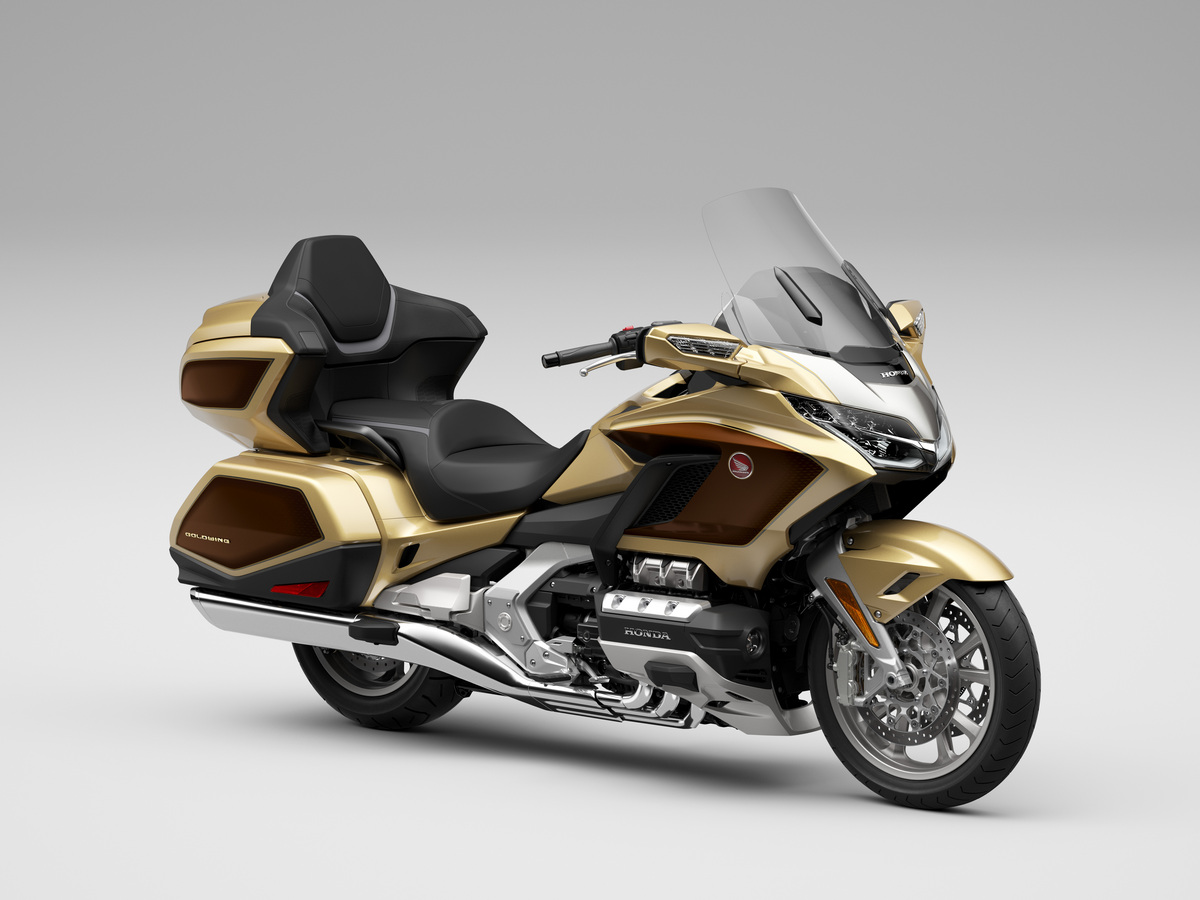

- MSRP
- 50th Anniversary Gold Wing Tour: $29,200
- 50th Anniversary Gold Wing Tour DCT: $30,200
- 50th Anniversary Gold Wing Tour Airbag DCT: $33,500
- Gold Wing Tour: $28,700
- Gold Wing Tour DCT: $29,700
- 2025 Gold Wing Tour Release Date: March

This year, a legend turns 50. Honda's iconic Gold Wing platform singlehandedly invented the touring category back in 1975, and it has never looked back, piling up the miles and smiles for half a century. Along the way, it has been the focus of a grassroots subculture, inspiring communities and events both real and virtual, and bringing touring enthusiasts together in the shared passion of experiencing the comfort and exhilarating performance that are only possible with a Gold Wing. Through its five decades on the market, the Gold Wing platform has not only changed the manner that people go touring on a motorcycle; it has also altered the way people think about touring on a motorcycle.
Commemorating the occasion, the 2025 Gold Wing platform gets several styling-focused updates, along with wireless compatibility for Apple CarPlay™ and Android Auto™. And of course the Gold Wing continues to offer the matchless smooth, comfortable, gliding ride that has long made it famously enjoyable for touring rides of any distance.
HISTORY
Designed with the simple but audacious objective to be the best motorcycle ever built, the original, 1975 Gold Wing was embraced as a touring machine by customers, many of whom outfitted their GLs with aftermarket luggage and front fairings. This inspired the future direction for the GL1000 Gold Wing.
For the 1980 model year, Honda's all-new follow-up model—the GL1100 Gold Wing—established what would become a regular practice with milestone Gold Wings, as the model grew significantly. In addition to its larger engine, the motorcycle had a longer wheelbase, more room for the rider and passenger, and increased fuel capacity (though it was actually lighter). Taking a lead from Honda customers, Honda also added a touring-specific Interstate version that came with a radio, though a naked version was also still offered. The Interstate came with a factory-installed fairing and luggage, as well as other touring-focused features.
Capitalizing on the successful reception of the Gold Wing Interstate, Honda in 1982 added an Aspencade version (named after a popular New Mexico motorcycle rally), which introduced the concept of luxury touring, with a larger seat, additional storage, a CB radio (previously only available as an accessory), and a special paint scheme.
The 1984 Gold Wing was once again larger, its engine growing by 97cc and offering more power and torque. The GL1200's swingarm and wheelbase were longer as well, and improved handling and comfort were made possible via a stiffer frame, repositioned engine and smaller wheels.
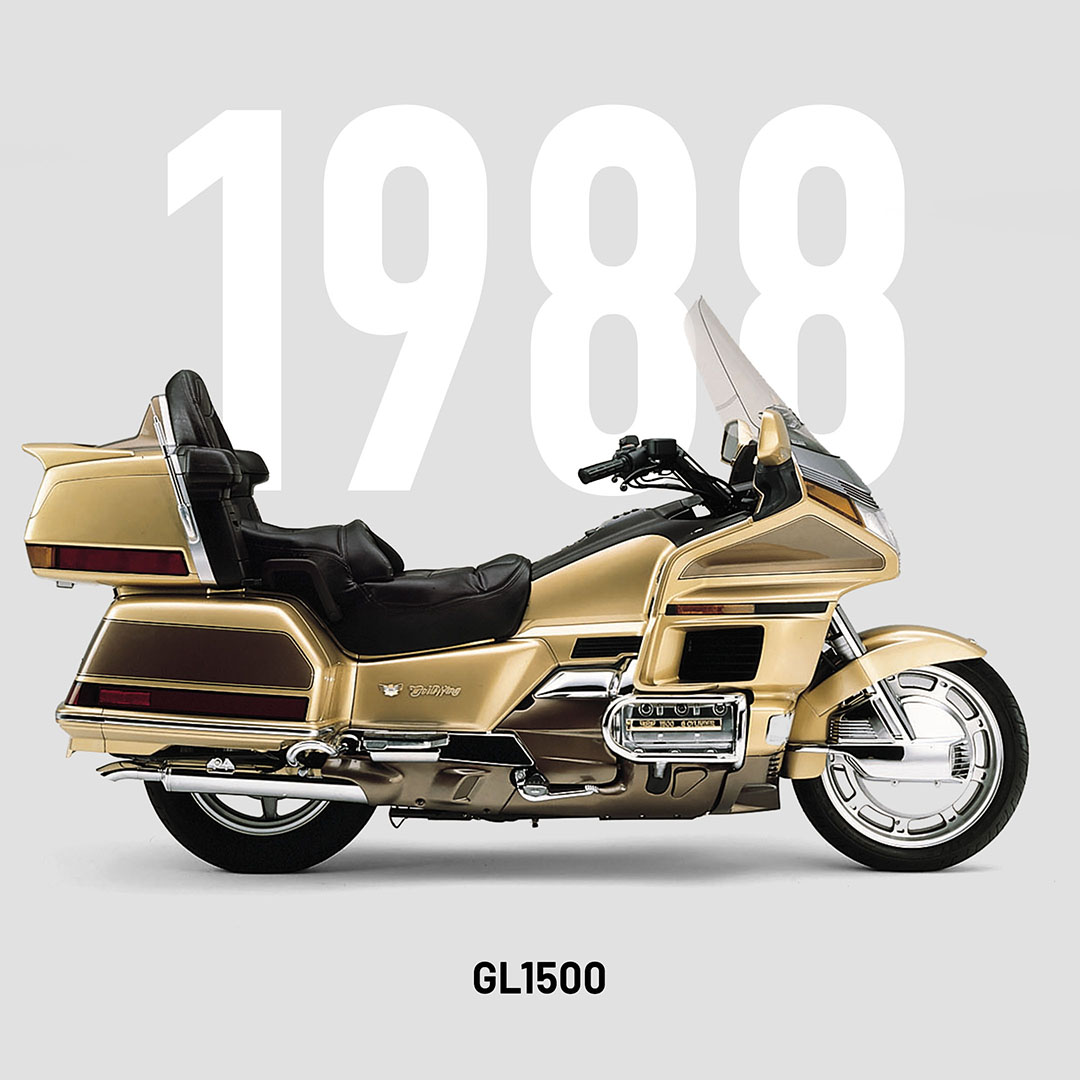
For 1988, the Gold Wing underwent what at the timewas the most comprehensive model development in Honda's history, its new engine growing two cylinders and achieving power and smoothness for which it would become renowned. The GL1500's chassis was new as well, redefining the limits for handling and comfort on a touring motorcycle. Also of note were the increased fuel capacity, improved brakes, and seamless fairing. Production was in the USA, from Honda's Ohio plant.
The sensational 2001 GL1800 brought fuel injection, an aluminum twin-spar frame, and optional ABS braking, and its 20 patents were a hint at the extensive technological innovations. Developed under Masanori Aoki, this next-generation GL featured an engine that was 312cc larger than that of its predecessor, but it also had an added fun factor, attaining sport-like acceleration and handling. In 2006, Honda introduced a Gold Wing model with navigation and the world's first motorcycle airbag, and in 2009, XM Satellite radio was added.

The evolution of Honda's most storied touring model continued in 2018, with the introduction of an all-new Gold Wing. Built on the same pillars of reliability and easy-to-use performance that had driven the platform to the forefront of the touring category year after year, this new version took each of the prerequisites for a good touring machine and improved in every way possible. Lighter, more compact, and more technologically advanced, this was a fun-to-ride Gold Wing that could just as willingly tackle city streets as it could take riders beyond the next horizon.
For the 2025 model year, Honda marks an important milestone in the Gold Wing platform's history, as the legendary touring machine celebrates its 50th anniversary.

NEW FOR 2025
- New colors for all trim levels.
- Apple CarPlay and Android Auto can now be used wirelessly on all Gold Wing versions.
- Given the widespread adoption of Apple CarPlay and Android Auto, the Gold Wing's native navigation system has been eliminated for 2025.
- "Since 1975" has been added to the Gold Wing logo that appears at the meter's "opening ceremonies" when the bike is turned on.
- On standard versions, a Gold Wing logo across the saddlebags and side fairings adds a bold styling treatment.
- A special 50th Anniversary badge is situated in front of the seat and on the Smart Key, commemorating the Gold Wing's important milestone (on all versions except for Light Silver Metallic).
- For model-year 2025, all Gold Wing versions in Eternal Gold, Bourdeaux Red Metallic and Matte Black Metallic (not Light Silver Metallic) come with two free commemorative gifts: a coffee-table book and a tabletop 3D 1:12 scale model. The model features a 1975 Gold Wing on one side and a 2025 Gold Wing on the other side.
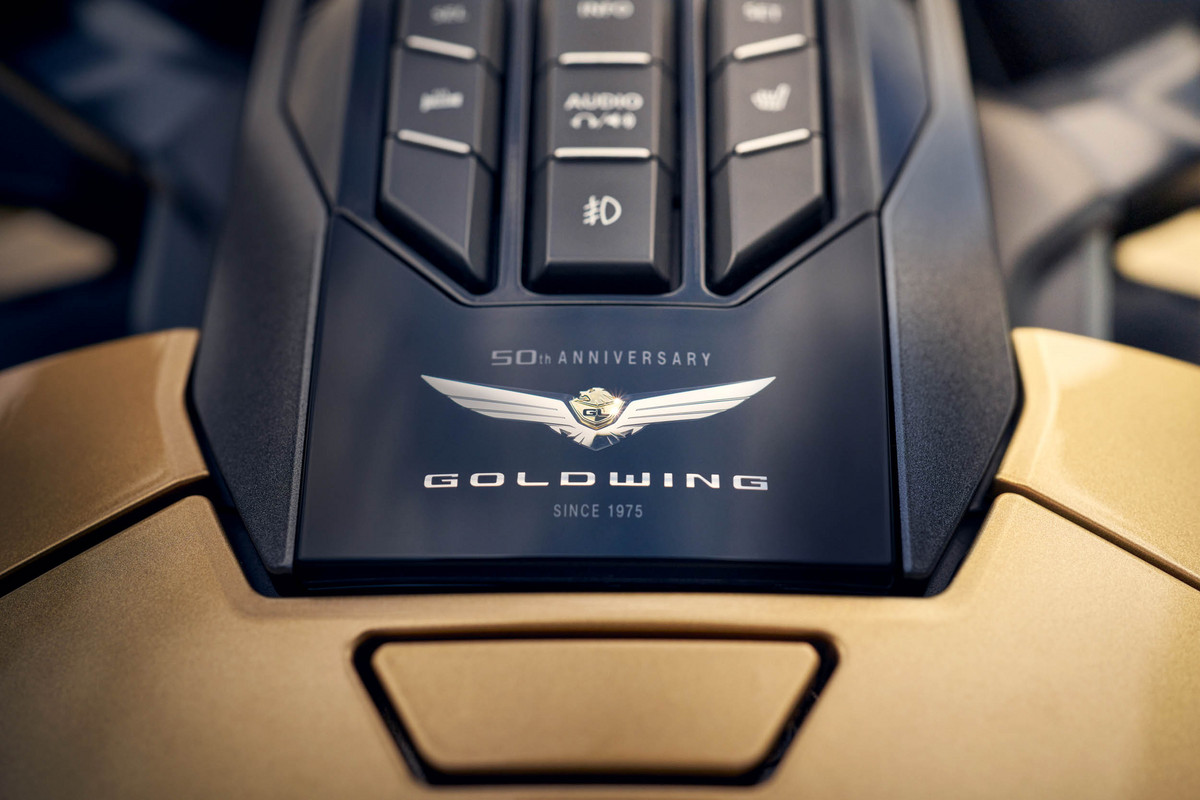
TRIM LEVELS
The Gold Wing is offered in two basic versions: a long-distance-riding-focused Gold Wing Tour, as well as a "bagger"-style standard version with no top case. Both configurations are available with either a standard gearbox or an automatic dual-clutch transmission. In addition, the Tour can be purchased in an Airbag version.

DESIGN / STYLING
In the Gold Wing, Honda has created a dynamic, visually compact package that perfectly matches the motorcycle's performance-first pedigree, while also prioritizing aerodynamic efficiency and heat management. The motorcycle is Honda to the core, with emphasis on polished look and feel. Designed with comfortable ergonomics, effective heat management and refined aerodynamics, the Gold Wing is well-suited for long days on the open road.
The Gold Wing's design emphasizes the bike's performance-minded origins, the engine feeling pronounced and the sharp lines hinting at the machine's lithe handling. Through meticulous airflow management, the bike slips through the air efficiently while still offering the great ergonomics that are a staple to long days on the open road.
Ergonomics
Performance should not give way to comfort, and the Gold Wing is proof that the two aren't mutually exclusive. A two-piece seat is used so that the rider can comfortably enjoy operating the machine, and the passenger can enjoy touring in absolute comfort. Hip support has been designed for minimal restraint, allowing the operator to easily move about the saddle and enjoy the Gold Wing's spirited soul on a twisting backroad. Likewise, the shape maximizes the potential for the rider to put his or her feet down at a stop, with a narrow junction between the frame and fuel tank.
Compared to traditional touring machines, the overall rider ergonomics (a key to comfort) place the handlebars forward, and the footrests are just slightly rearward.
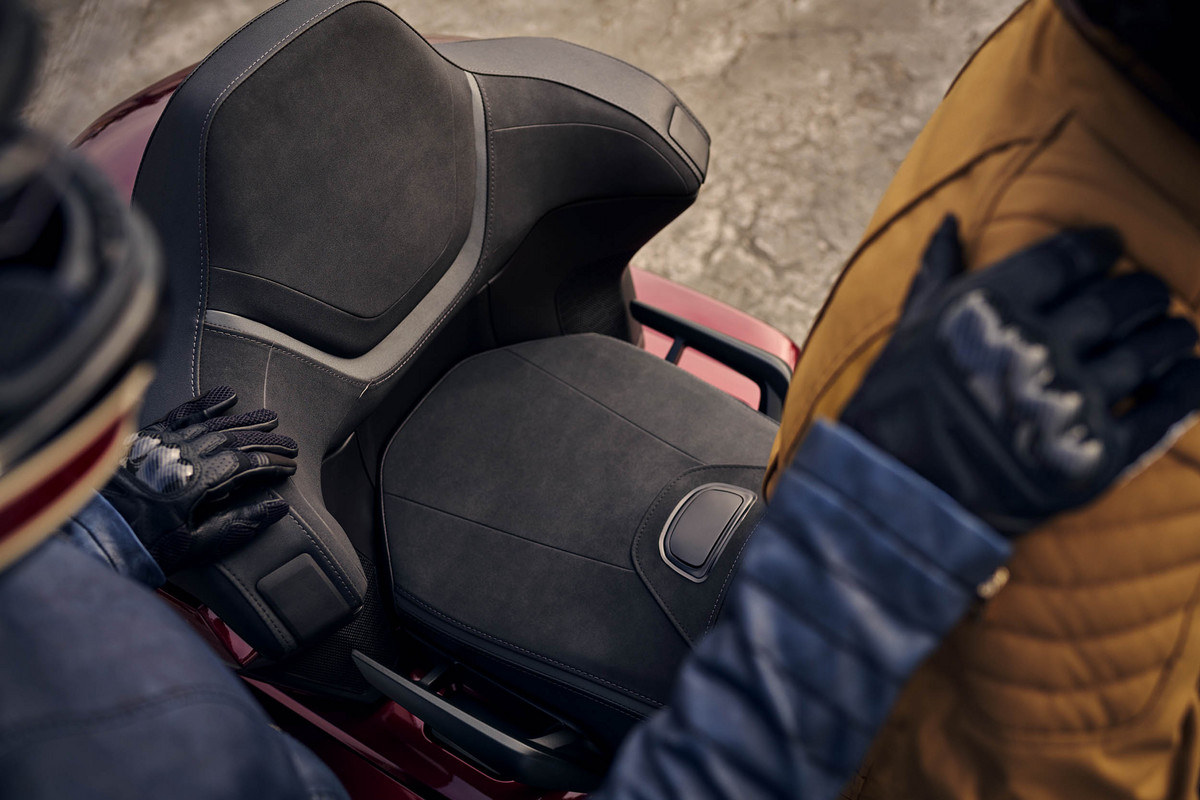
The passenger backrest angle is 24.5º for a relaxed riding position that reduces pressure on the passenger's hips. The passenger backrest is 30mm tall, and the thickness of the backrest foam is 5mm, for exceptional comfort on long rides. A premium, suede-like seat cover enhances feel and appearance.
Fairing
With the Gold Wing, Honda reimagined the meaning of air management, working to flow air smoothly over the rider and passenger rather than endeavoring to put them in a windless, vacuum-like condition. Air-guiding ducts flow optimal amounts of air into the rider area, allowing a true motorcycling experience. Fairings with high aerodynamic efficiency complement an impressive power-to-weight ratio to maximize fuel mileage.
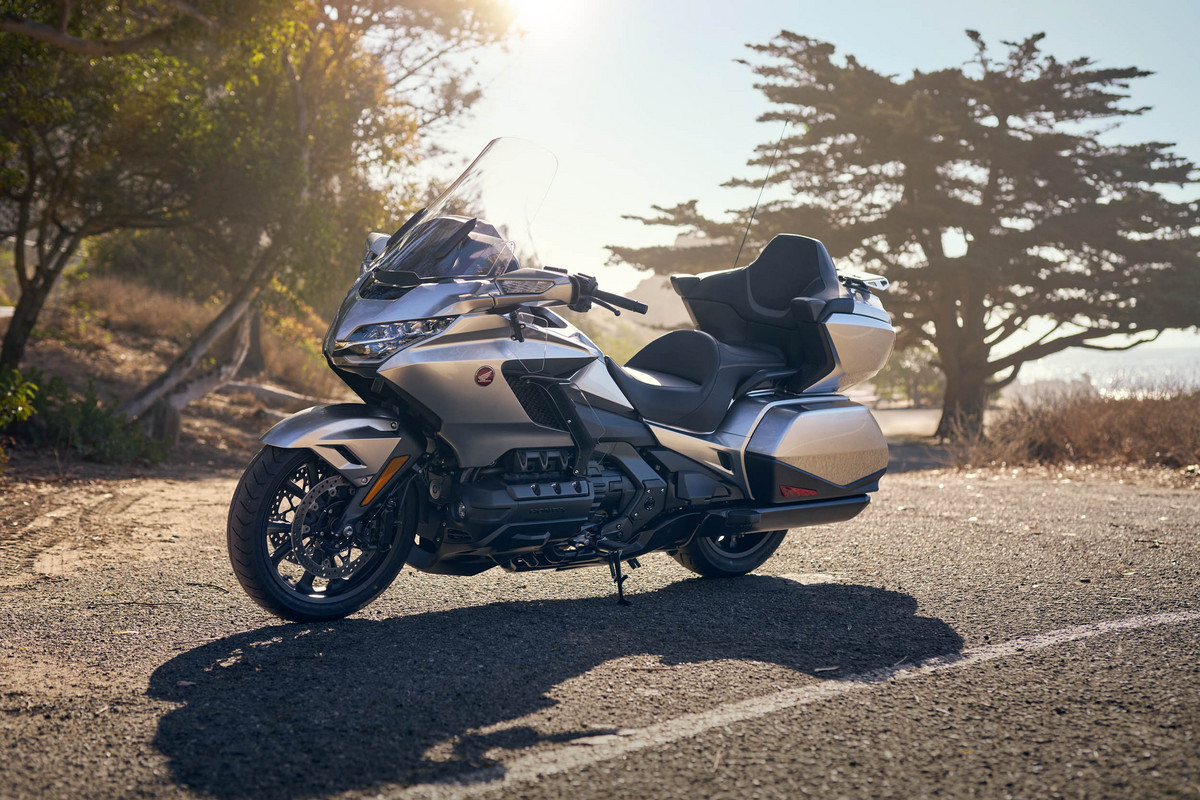
By making the side-mount radiator compact and high-performance, designers managed to minimize the front cowl width, while simultaneously earning a high degree of freedom in terms of styling design. In a move that was key to helping with the aggressive overall look, Honda engineers exposed the exhaust pipes, highlighting the Gold Wing's mechanical attitude.
The Gold Wing's standout fuel economy enables the bike's fuel tank to be relatively small (5.5 gallons, including .8 gallons Reserve), for optimal vehicle packaging and low weight.
Windscreen
An electric windscreen provides the rider with a great degree of control over airflow. Manipulated via a switch on the left handlebar, its height and angle are adjusted in a stepless manner to achieve the ideal amount of airflow for city-street riding or higher-speed passes down the interstate. In this way, each rider can always enjoy the most appropriate wind protection, based on the situation and personal preference.

Thanks to a short engine and linked, double-wishbone front-suspension system, which enabled engineers to bring the riding position forward, and thus bring the rider close to the windscreen, it was possible to minimize the size of the windscreen itself. The three Tour versions come with a tall windscreen, and the two standard Gold Wing versions come with a shorter windscreen, with the taller windscreen being available for that model as a Honda Accessory. Various wind deflectors are also available.

Luggage
Top trunk on Gold Wing Tour versions has a capacity of 61 liters, enough to fit an impressive amount of luggage or two XXL helmets, even when those helmets are outfitted with headsets. The right and left saddlebags each have a capacity of 30 liter storage. Total storage capacity on Tour versions was designed to accommodate enough supplies for two people traveling for three nights/four days.

For smooth operating, the saddlebags and rear trunk use high-quality lid dampers. The rear box from Tour versions can be purchased as an accessory and installed on standard versions, in cases where those customers desire additional storage space.

Technology
The Gold Wing platform features Apple CarPlay integration and Android Auto capability, enabling owners to seamlessly enjoy application services such as music, phone calls and messaging. For 2025, both Apple Car Play and Android Auto can be used wirelessly.

For rich midrange audio, the Gold Wing platform features 45 watt speakers—Tour versions include two speakers at the front fairing and two at the trunk, while standard feature two speakers at the front. Volume-adjustment level is automatic for a quality experience in a wide range of riding conditions. The navigation software includes speed-limit information and four options for map color. The Gold wing comes standard with an XM radio antenna, and the Airbag version's collision-judgment system is situated close to the center of gravity for optimal mass centralization.
Lighting
LED technology is used for all lighting on the Gold Wing, with the multiple-lens front lights forming the "wing lines" and the multiple-lens taillight creating an image of high quality. LED front turn signals are built into the mirrors, while LED rear signals are built into the same unit as the taillight and stop lamp on each side. The rear turn signals are in all red for a clean, stylish look. The systems are designed to cancel automatically after a turn is completed.

An LED fog light, high-mount stop lamp, and LED luggage-box inner light are all available as Honda Accessories.
ENGINE / DRIVETRAIN
Honda's iconic, liquid-cooled, horizontally opposed six-cylinder engine is the heart of the Gold Wing, designed to be compact, fuel efficient and versatile in varying riding situations. The engine configuration offers the benefits of low center of gravity, minimal vibration, and quiet running, but it was developed to be light and compact, through the design of its crankshaft and Unicam® valve train. The short engine configuration enables the engine and seating area to be positioned forward in the chassis, affecting weight bias to promote sporty handling. Available with a 6-speed manual transmission or with Honda's highly advanced, new-generation 7-speed automatic DCT, the engine offers strong performance and magic-carpet-ride smoothness.

The cylinder bore and stroke are both 73mm, for a total displacement of 1,833cc. The cylinder sleeves are aluminum, contributing to the low engine weight. For a compact overall package, the crankshaft is formed from a high-strength SCM440H steel alloy material that enabled engineers to achieve a thin crank web and minimize the distance between cylinders, at 81mm. The crank pulser (which detects the engine speed and the piston positions, for controlling fuel-injection quantity and ignition timing) is positioned to the rear of the crankshaft, allowing the crankshaft itself to be positioned forward. Together, these features result in an engine that is short at the front, placing vehicle weight and rider position forward. Hugely impactful, this promotes sporty handling.
The Unicam valve train, a design that has been proven in Honda's legendary CRF450R motocrosser, uses a finger-follower rocker-arm system on the intake side and roller rocker-arm system on the exhaust side. Doubly beneficial, this design enables elimination of the valve-lifter-support structure, resulting in a weight minimization while also enabling the engine to be compact. The roller rocker-arm system on the exhaust side also minimizes friction, contributing to good fuel efficiency. A molybdenum coating on the piston skirts has the same positive effects.


Thanks to the aerodynamic efficiency and weight savings, it's possible to use a relatively small 5.5-gallon total fuel-tank capacity, for good handling performance while maintaining great range. Furthermore, the small fuel tank optimizes mass centralization and further minimizes weight, bringing the mass toward the center of the motorcycle for excellent agility and handling.

The engine uses four valves per cylinder in pent-roof-type combustion chambers for good combustion efficiency. Intake valves measure 27mm, whereas exhaust valves are 24mm. For added weight minimization, cylinder sleeves are made from aluminum, the camshaft is manufactured from FCD600M (a lightweight, high-strength material), and water-cooling routes are simple. All this helps to create a package that is compact and performance-minded on the road, with a great power-to-weight ratio.
Intake System
Intake efficiency was developed for responsiveness and torque, while the intake system itself is quite light—there's just one 50mm throttle body, the intake manifold is just 3mm thick, and the inner diameters of the intake manifold are minimized. Intake-manifold volume was optimized for efficiency purposes, as have the positions of the intake ducts. This design, which creates a swirl effect on the incoming air, also results in an effective use of the entire air filter. The intake-duct shape and size have been optimized for good response and torque at initial throttle openings.

Exhaust System
To create an exhaust sound worthy of the Gold Wing, a structure was designed for the sequence leading from the muffler to the exhaust pipe, with an absence of fiberglass in the system ensuring an appropriately sporty sound quality.
Starter
In another weight-minimizing measure, all Gold Wing versions feature an integrated starter generator system (ISG), which integrates the generator and starter-motor functions into one component. This incorporation allows for elimination of the starter motor and starter-system wiring, which saves weight and reduces noise during starting.

TRANSMISSION
For transferring power to the rear wheel, the Gold Wing is available with a six-speed manual transmission or Honda's advanced seven-speed automatic dual-clutch transmission (DCT), each of which features technology for ease of use and a quiet, enjoyable riding experience.
Dual Clutch Transmission
In the world of powersports, Honda is a pioneer with dual-clutch transmission technology, having first offered it on the 2009 FourTrax Rancher multipurpose ATV, followed by the 2010 VFR1200F sport-touring motorcycle. Since then, the technology has been offered on Honda adventure bikes, cruisers, ATVs and side-by-sides. While similar systems can be found in a number of high-performance sports cars, Honda pioneered the use of DCT in the powersports world and has accumulated experience and improved the technology along the way. The introduction of the 2018 Gold Wing welcomed DCT to the touring category, and it was well-received, thanks in part to the fact that it enables riders to focus attention on riding, without concern of stalling. Since the introduction of DCT on the Gold Wing, a majority of customers choose it over the manual transmission.

DCT delivers consistent, rapid, seamless gear changes, and very quickly becomes second nature to use. It utilizes two clutches—one for startup and first, third and fifth gears, the other for second, fourth and sixth gears, with the main shaft for one clutch located inside that of the other. Each clutch is independently controlled by its own electro-hydraulic circuit. For a gear change to occur, the system pre-selects the target gear through the clutch not currently in use. The first clutch is then electronically disengaged as the second clutch simultaneously engages. As the twin clutches transfer drive from one gear to the next with minimal interruption to rear-wheel drive, gear-change shock and pitching of the machine are minimized, resulting in shifts that are not only smooth, but direct. The extra benefits of durability (as the gears are less likely to be damaged by missing a shift), low-stress urban riding and reduced rider fatigue add to the appeal of DCT.

In the case of the Gold Wing, the DCT also features Walking and Reverse modes, with creeping speed for situations like maneuvering the motorcycle around a parking space. In Walking mode, one clutch enables forward movement, and the other clutch enables rearward movement. In either direction, engine speed is controlled by the throttle-by-wire system, and clutch engagement is ideally modulated. Walking mode speeds are limited to 1.1 mph in forward direction and .75 mph in Reverse direction, with the rider easily controlling the system through the + and – buttons on the left handlebar switch. Engineers devised a special chain-and-gear system that utilizes DCT shafts for the reverse function, thereby eliminating the need for a traditional mechanism.

High-strength materials enabled engineers to minimize the face-width of each gear, contributing to a compact engine. In addition, this latest-generation DCT improves performance through damper rubbers that reduce shift noise, realizing a shift feel worthy of a flagship model.

The fork-shaft dampers are affixed to both ends of the fork shaft, suppressing the noise that is generated when the edge face of the fork shaft, which supports the shift fork that moves the gears during shifts, strikes the engine case, a situation that occurs when energy is released during shifts. The master-arm damper works much the same, mitigating any sound created when the master arm strikes the stopper pin that regulates its movement. Meanwhile, the DCT clutch-center damper—a spring damper installed between the clutch and the main shaft—absorbs torque and reduces noise caused by the engagement between dogs and the clutch during shifts. Thanks to a good coordination between clutch control and the throttle-by-wire system, shift shock and shift time are both minimized, especially in Sport mode.

The lower gears are characterized by close ratios for a narrow change in engine speed and driving force when shifting gears. Meanwhile, the taller gears have a wide ratio for low engine speeds at high-speed cruising.
Standard Transmission
Gearbox technology and benefits are not limited to the DCT, as the six-speed manual transmission also features a cam damper between the clutch and transmission to minimize noise and shock, and to enhance durability. This gearbox enables low engine speeds when cruising at 60 mph, which creates a quiet overall riding experience. Each manual-transmission version of the Gold Wing is equipped with an assist and slipper clutch, to minimize clutch-operation load, as well as shift shock during downshifting. For the reverse mechanism, the electric starter motor is used.

TECHNOLOGY
The Gold Wing is equipped with innovative electronics for seamless performance, including a throttle-by-wire system that features multiple ride modes and convenient electronic rider aids. This advanced technology highlights the Gold Wing's unmatched comfort and excellent performance.
Riding Modes
The four riding modes available on all Gold Wing versions are Tour, Sport, Econ and Rain, each with distinct settings that help tailor the riding character of the motorcycle for the specific riding conditions. The process of switching modes is completed when the rider totally closes the throttle.

The default riding mode, Tour mode can deal with the most wide-ranging conditions. This setting achieves a good balance between the outstanding comfort characterized by a touring model, and the dynamic performance potential of this bike. The stress-free riding character enables powerful acceleration with throttle operations when climbing a hill and offers appropriate response to other changes in the terrain, while curbing engine speed at low levels. The DCT versions faithfully respond to the rider's acceleration demands through automatic downshifting at the appropriate moment (according to the throttle position).
Enabling the rider to fully enjoy the Gold Wing's dynamic performance, Sport mode features powerful acceleration thanks to sharp responsiveness. With DCT versions, the automatic-shifting schedule enables the engine to climb to higher speeds. While combined braking bias is relatively unchanged in the other three modes, Sport mode applies more pressure to the rear when the front brake is applied.

Econ mode gives expression to the riding character as recommended by Honda when riding in a relaxed manner on roads in cities and suburbs. Through the mild acceleration and deceleration characteristics and the suspension's soft damping characteristics, relaxed cruising is possible. In the automatic modes of the DCT versions, the shifts occur at low engine speeds, also contributing to improved fuel efficiency.
Rain mode is intended for riding in low-grip situations, such as on wet and/or dirty roads. The mode provides acceleration and deceleration characteristics that—in comparison to Econ mode—are even milder in response to throttle operations, with added torque control. With DCT versions, the shifts occur at low engine speeds.
Honda Selectable Torque Control (HSTC)
Designed to help the rider manage rear wheel slip, Honda Selectable Torque Control calculates the slip ratio of the rear wheel by measuring the vehicle-speed signal of the non-contact ABS wheel-speed sensors. When slip is detected, the system steps in through adjustments to the throttle valve and fuel injection, in combination.
Hill Start Assist
Hill Start Assist makes it simpler to resume riding after stopping on an ascent. When HSA is activated in such situations, and the rider releases the brake, the ABS modulator generates hydraulic pressure on the rear-brake caliper, and the motorcycle will not roll backward if the rider uses the throttle to move forward within three seconds. Throughout the entire process, an HSA indicator illuminates on the display.

Cruise Control
Ideally calibrated through the throttle-by-wire system, Honda's cruise control works to deftly manage a set speed in varying conditions, such as when traveling up a hill. For easy reference, the rider's set speed is clearly shown on the meter.
Smartphone Compatibility
All Gold Wing versions are compatible with Apple CarPlay, which enables the rider to access Apple Music and Maps, make phone calls, and send messages, all through the bike's TFT display or by voice through Siri. Android Auto integration enables customers with Android 5.0 or later smartphones and the Android Auto app to seamlessly enjoy application services such as music, phone calls and messaging.
New for 2025, both Apple CarPlay and Android Auto can be used wirelessly on the Gold Wing platform.
.jpg)
Smart Key
To start the engine, the rider only needs to have the Smart Key in his or her possession and to turn the main switch knob to the right, then press the start switch. To stop the engine, the switch knob must be turned to the left. Owners can also lock the steering by turning the handlebars while simultaneously turning the switch knob one more position to the left. As an added feature, the main switch knob glows when the owner approaches the bike with the Smart Key. For security purposes, it is possible to turn the Smart Key off.
The Gold Wing is outfitted with Vehicle Viewfinder, meant for helping to locate the motorcycle (in large parking lots, for example). To activate, one must press and hold the Smart Key call button, which activates the motorcycle's hazard flashers and activates the horn.
.jpg)
Airbag
Honda was the first motorcycle manufacturer to outfit a two-wheel model with an airbag, starting in 2006, and it continues that trend with the current Gold Wing Tour Airbag DCT, which comes equipped with a state-of-the-art airbag system. In the event of a frontal collision, the system slows the rider's momentum as he or she is thrown forward.
The system consists of an airbag module and a collision judgment system, which operates via an acceleration sensor and main control unit. Thanks in part to information learned in collision tests and computer simulations completed at an all-weather omnidirectional collision-experiment facility, the system is designed to be lightweight, and it is positioned close to the center of gravity for optimum mass centralization.
Miscellaneous
The meter has an analog speedometer on the left, an analog tachometer on the right, and a 7-inch full-color thin film transistor (TFT) liquid-crystal display that provides infotainment-related information such as audio and navigation app icons. The screen is also where the rider views the audio and navigation systems, as well as settings for the individual rider-aid systems, and where settings for systems like HSTC and electric preload adjustment are confirmed. The switches, used for selecting settings and controlling the systems, are centrally located in the console area.

Rather than only indicate when pressure drops below a certain level, the Gold Wing's Tire Pressure Monitoring System constantly communicates pressure via numerals on the meter.

An optional feature, the Home Link System is a convenience when rides are just beginning or coming to an end, as it enables the rider to program the motorcycle with garage-opening and -closing remote-control information. The rider simply presses the button on the center console, and the garage opens or closes, while a light on the ride side of the meter indicates the operation.
All Gold Wing versions are equipped with heated grips, and the Tour versions also feature heated seats as standard equipment. They also have a cruise-control function for relaxed cruising.

CHASSIS
Offering the optimal balance between stability and maneuverability, the Gold Wing chassis is engineered for comfort on the open highway and precision on tight backroads. The double-wishbone front suspension and Pro-Link® rear-suspension system complement the robotically welded aluminum frame, resulting in a smooth, confidence-inspiring ride.
.jpg)
Frame
The twin-spar frame was designed with plate thickness carefully studied in specific areas to achieve ideal rigidity and flex characteristics. This was done with the help of calculations for stress on each area of the frame, and the process helped minimize weight.
Mass centralization was achieved through a relatively short seat rail, with the rider and passenger placed forward. Thanks to a low center of gravity, maneuverability in all riding situations is impressive.

Swingarm
At the rear, a single-sided swingarm with built-in driveshaft uses a pivot-area structure, with the arm secured to the frame only on the left side, while the function of the right pivot area is limited to supporting the structure. This arrangement affects the stress on the frame's swingarm pivot plates, giving engineers more freedom in the approach to frame rigidity, ultimately enhancing maneuverability. Needle bearings are used at the swingarm mounting points.
Brakes
The Gold Wing is outfitted with six-piston, radially mounted Nissin front-brake calipers and 320mm front rotors, a clear indicator of the model's sporty nature. The single rear brake rotor measures 316mm, and the caliper has three pistons.

The electronically controlled combined ABS works in a way that optimally distributes braking force to the front and rear wheels. Minimizing weight, the system is operated by one small, light, circulation-type ABS modulator that is integrated with the brake ECU. The combined ABS settings are linked with the riding modes to automatically adjust to braking characteristics ideal for the riding situation.

Wheels & Tires
The tires were specifically designed for the Gold Wing, with the 200/55-R16 rear tire offering good stability at low speed, a decision made possible by the motorcycle's increased agility in other areas. The front tire measures 130/70-18.
SUSPENSION
The sporty character of the Gold Wing platform encourages riders to search for the next set of tight, twisting corners, and the suspension solutions are meant to help tackle these sections of road with confidence, while still providing unparalleled comfort on the highway. The Gold Wing manages this task through a unique double-wishbone front-suspension configuration and Pro-Link® rear-suspension design. Both suspension systems use Showa shocks, with the Gold Wing Tour models featuring electric preload adjustment for easily selecting the appropriate preload setting, depending on if a passenger and/or luggage are being carried.

On the Tour versions, front and rear damping force are electrically adjusted, with a stepping motor moving the needle in each system to control the oil flow rate and adjust front/rear damping force to mode-specific settings. These suspension settings are linked to individual riding modes and do not change until a new riding mode is selected. There are four electric preload settings to choose from—in order from soft to stiff: Rider; Rider + Luggage; Rider + Passenger; Rider + Passenger + Luggage. (The non-Tour versions have manually adjustable rear preload.)
Front Suspension
The Gold Wing's double-wishbone front-suspension system offers multiple benefits, the first being a minimization in shock transmitted to the handlebars, a common concern with a conventional telescopic fork. This is accomplished through a design that incorporates a pair of forked arms, and does away with the friction between the outer and inner tubes of telescopic forks, minimizing total shock transmitted from the road surface to the handlebars.

A second benefit of the double-wishbone front-suspension system is a minimization in inertial mass for the front-end components that are manipulated via the handlebars. As a result, Honda engineers were able to spec a stability-enhancing 66.9-inch wheelbase while simultaneously maximizing responsiveness and nimbleness, key to ease of use on city streets. Use of bearings for all shaft bushing areas further minimizes friction for both stroke and steering.
The double-wishbone front-suspension system contributes to a compact vehicle package, the stroke trajectory of the suspension requiring minimal clearance between the front tire and the engine area. As a result, engineers were able to place the motorcycle's engine forward, which in turn enabled them to place the rider position forward. The result is an optimized load allocation, with a relatively high percentage of weight on the front wheel, contributing significantly to the Gold Wing's responsive, nimble handling and overall sporty attitude.
The front-suspension system features bearings for all shaft bushings, minimizing friction for both stroke and steering. The convenient, electrically controlled suspension-damping adjustment uses a stepping motor acting on a needle to control oil-flow rate.
Rear Suspension
In the back, a Showa shock absorber and Pro-Link system featuring progressive reaction ensures a comfortable ride. Spherical joints at the top and bottom of the shock help to cancel out torsion of the Pro-Arm® structure, helping to improve the ride.
Honda ACCESSORIES
More than 50 Honda Accessories are offered for the various Gold Wing versions, enabling rider customization or to meet rider-specific needs.

For model-year 2025, all Gold Wing versions in Eternal Gold, Bourdeaux Red Metallic and Matte Black Metallic (not Light Silver Metallic) come with two free commemorative gifts: a coffee-table book and a tabletop 3D 1:12 scale model. The model features a 1975 Gold Wing on one side and a 2025 Gold Wing on the other side.

